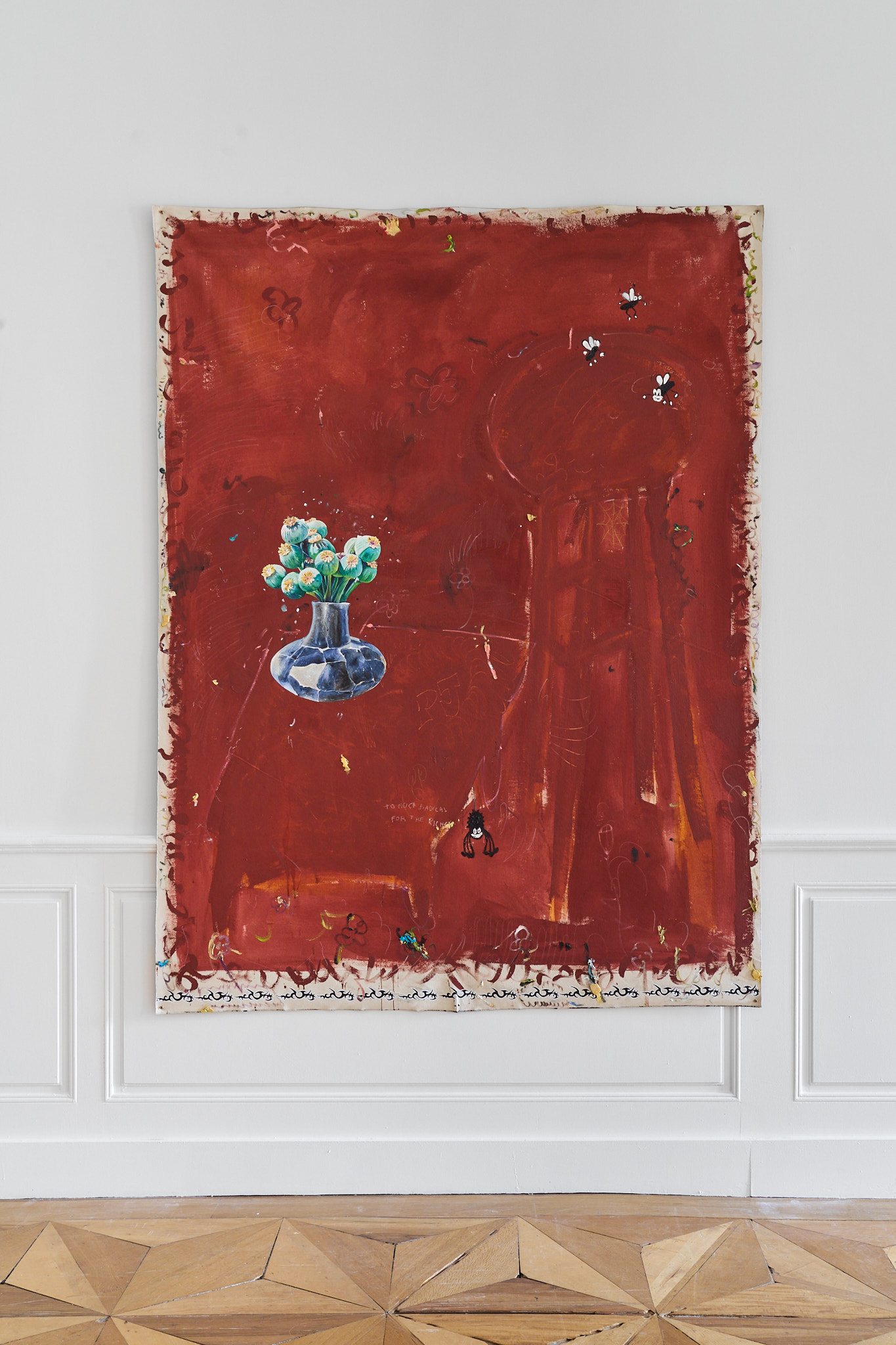
Paulo Nimer Pjota - 2019
Presented by Mendes Wood
03/09/2025 - 19/12/2025
The finest artists resemble acrobats, weaving together disparate fragments of imagery and materials. Paulo Nimer Pjota’s earliest works possess such a nimble quality, allowing the Brazilian artist to thread his serpentine way between various historical periods and cultural traditions. Born in São José do Rio Preto, Pjotastarted painting in his early teens, inspired by his hometown’s colorful, impastoed façades. This led to his manner of constructing depth through overlapping layers of paint: tempera, oil, and acrylic. The rural cityscape also provided a prefiguration of his repertoire: a tempestuous collision of vernacular, resistant ciphers, gleaned from the bustling counterculture of a place without museums – freed from arid, arbitrary taxonomies and hierarchies.
This untethered mindset would remain. As a young adult, Pjota moved to São Paulo and underwent academic training at the University Center of Fine Arts. He made a name for himself by the early 2010s through his erudite yet playful juxtaposition of references, bridging Greco-Roman and pre-Columbian mythologies, cartoon figures and seventeenth-century Flemish painting, Japanese printmaking and atemporal tattoos. Allcollide as if to better render obsolete the foundational exclusions upon which Western canons had been erected. The artist has often spoken of mythological patterns contaminating hitherto disjointed points, referencing writerJoseph Campbell’s “monomyth”. One can also consider art theory’s shift, during those years, to circulationrather than objecthood. Scholar David Joselit observes: “In place of aura, there is buzz.”
In Brussels, Pjota’s solo presentation brings together eight canvases from 2019 to 2024. It follows the solo booth prize at Art Brussels that the artist was awarded in 2024, which was supported by TheMerode. The pieces, selected from private collections, provide a telling insight into a fundamental shift in the artist’s practice, as they bridge two distinct periods. Take, for instance, two of the oldest works, which uncover the distortedpersistence of imperialist-colonial legacies. A grande heroina (2019) sees the poppy plant as a metonym for the trafficking of opium, following it through ancient and modern asymmetric warfare. The iconographical elements are distinctly delineated against their background, in a similar pictorial manner to Todo império quebra como um vaso (2020-2021). There, the unending collapse of grand empires is signified through the superimposed grins of a carved Halloween pumpkin hovering above a gorgon on a Greek vase. Such a rebus hints at a wider interconnectedness, apparent to those wary of the obvious.
Three years ago, Pjota shifted to a more subjective positioning toward his subject matter. “I call these new paintings dreamscapes”, he explains. “Now, mythology comes to me in another way. It is about creating a meditative atmosphere, concentrating on the connections between the separated elements.” These luxurious canvases are intricate universes that radiate a Dionysian life force. At TheMerode, symbolic poppies transforminto enchanted flowers, teeming with crawling insects, sprouting seeds, and starry patterns. Fauno com máscarade sol (2024), for instance, introduces a crepuscular scenery in muffled tones of mysterious purple, burnt yellow, and burnt sienna. A faun lurks in the shadows, donning a mask stolen from the sunken sun, echoing the latter’s appearance in the bright, diurnal, and almost diaphanous Margarida com sol (2024). As we discover additionaldetails, we remain transfixed – spellbound.
This fall, Pjota presents his shifting universe in two locations simultaneously. While TheMerodesurveys recent evolutions, Mendes Wood Gallery in Paris displays his most current creations with a solo show titled “Os alquimistas estão chegando” [The alchemists are coming] that leans into the artist’s newfound spellbinding hybridity. In front of any one of Pjota’s compositions, however, the same effect seizes us. To borrow anthropologist Alfred Gell’s words, describing art’s effect on its viewers: “This is captivation, the primordial kind of artistic agency.”
Written for Art Salon N°6 by Ingrid Luquet-Gad, Art Critic
About the curator:
Mendes Wood DM was founded in São Paulo in 2010 by Felipe Dmab, Matthew Wood, and Pedro Mendes to exhibit international and Brazilian artists in a context conducive to critical dialogue and the cross-pollination of ideas. Inspired by a belief that artistic practices broaden the scope of human agency and have the power
to change the world, the gallery cultivates a program premised on conceptualism, political resistance, and intellectual rigor. Central to the program is a concern for regional difference and individuation while still fostering cosmopolitanism and collaboration.
In 2017, Mendes Wood DM inaugurated its first European exhibition space in Brussels, founded in partnership with longtime friend and collaborator Carolyn Drake Kandiyoti. Located on three floors of a historic townhouse in the Sablon, the gallery lends itself to ambitious curatorial projects and comprehensive monographic exhibitions.
In 2022, Mendes Wood DM opened an exhibition space in New York’s Tribeca neighborhood. The expansion is a natural evolution of the gallery’s presence in North America, emphasizing a meaningful conversation with the Global South and affirming the gallery’s commitment to mounting significant exhibitions for a wider audience. In the same year, Mendes Wood DM established an exhibition and residency space in Germantown, NY, to create a contemplative environment for ideas, creation, and exchange. Located in an eighteenth-century property in the Hudson River Valley, the space navigates between regional and global perspectives. Leading contemporary artists are presented alongside projects highlighting historical and regional interest.
The gallery established a Paris location in 2023. The exhibition space is housed on the first two levels of the Hôtel de l’Escalopier in the Place des Vosges in the Marais. The building dates to the early seventeenth century and is situated at the northern entrance of the oldest planned square in Paris. This new step is a reflection of a long-standing dream to create a space of artistic exchange in a city that both nourishes and inspires Mendes Wood DM.